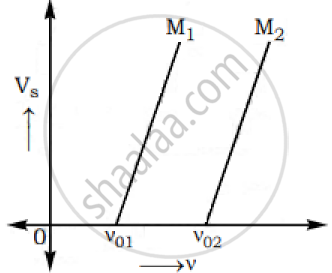Advertisements
Advertisements
प्रश्न
Ultraviolet light is incident on metals P, Q and R, having work functions 8 eV, 2 eV and 4 eV respectively,
- Which metal has lowest threshold frequency for photoelectric effect?
- For which metal is the value of Emax minimum?
(Note: Emax is maximum kinetic energy of the emitted photoelectrons.)
उत्तर
- The metal (Q) with a work function of 2 eV has the lowest threshold frequency since E0 = hv0.
-
Since, Emax = E - E0, the metal (P) having work function of 8 eV will have minimum Emax.
APPEARS IN
संबंधित प्रश्न
State two important properties of photon which are used to write Einstein’s photoelectric equation.
A proton and a deuteron are accelerated through the same accelerating potential. Which one of the two has less momentum?
Give reasons to justify your answer.
Radiation of frequency 1015 Hz is incident on two photosensitive surface P and Q. There is no photoemission from surface P. Photoemission occurs from surface Q but photoelectrons have zero kinetic energy. Explain these observations and find the value of work function for surface Q.
Radiations of two photon's energy, twice and ten times the work function of metal are incident on the metal surface successively. The ratio of maximum velocities of photoelectrons emitted in two cases is:
Threshold frequency for photoelectric effect on sodium corresponds to a wave length 5000. Its work function is ______.
Who indirectly determined the mass of the electron by measuring the charge of the electrons?
The slope of frequency of incident light and stopping potential for a given surface will be
Which of the following is/are true for cathode ray
- Calculate the energy and momentum of a photon in a monochromatic beam of wavelength 331.5 nm.
- How fast should a hydrogen atom travel in order to have the same momentum as that of the photon in part (a)?
The graphs below show the variation of the stopping potential VS with the frequency (ν) of the incident radiations for two different photosensitive materials M1 and M2.

Express work function for M1 and M2 in terms of Planck’s constant(h) and Threshold frequency and charge of the electron (e).
If the values of stopping potential for M1 and M2 are V1 and V2 respectively then show that the slope of the lines equals to `(V_1-V_2)/(V_(01)-V_(02))` for a frequency,
ν > ν02 and also ν > ν01
